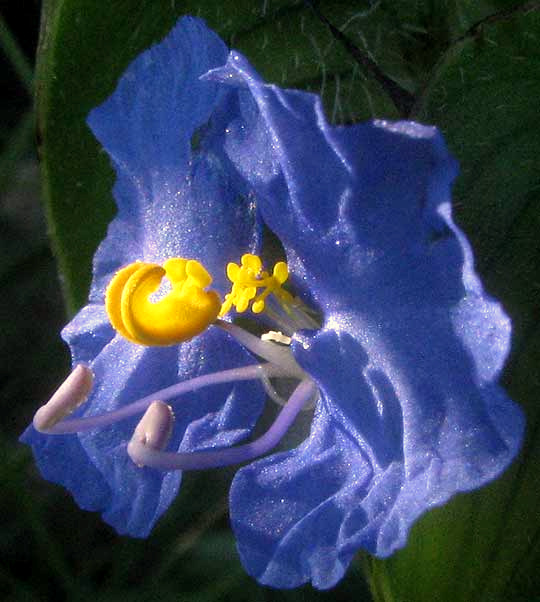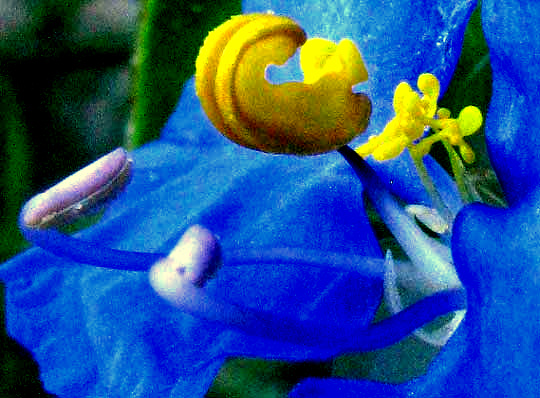Excerpts from Jim Conrad's
Naturalist Newsletter
from the June 9, 2013 Newsletter issued from the Frio Canyon Nature Education Center in northern Uvalde County, southwestern Texas, on the southern border of the Edwards Plateau; elevation ~1750m (~5750 ft); N29.62°, W99.86°; USA
DAYFLOWER
The cabin's owner pays a fellow to come mow the lawn. Happily, it's hard to get the mower beneath the Spineless Pricklypear in the backyard, so a veritable tiny prairie survives with more species diversity than all the rest of the mowed area. Nowadays in morning's first light, when the low sun's rays slant in just right, there's a spectacular burst of blueness there a little over an inch across (3cm) that's worth getting down on your knees in the dewy grass to look at closely. It's shown below:

The structures and colors here are so surreal that even if you know your wildflowers you may not at first recognize this as a dayflower blossom. Dayflowers are members of the genus Commelina, of which about 170 species are recognized worldwide, with nine occurring in North America. Most species are tropical. Dayflowers are members of the Spiderwort Family, the Commelinaceae, and they're monocots, along with lilies, irises and grasses. A close-up of the strange structures in the blossom's center is shown below:

In the above photo you might guess that the items in the flower's center are the male stamens and female style, but, what's what? The two lower, pale violet things are vaguely similar to "normal" stamens consisting of slender filaments topped by baglike anthers that open to release pollen, and that's what they are. But the thing in the middle looking like a splayed banana peeling atop a stalk also is a stamen, just a much modified one, maybe the brightness and largeness of its anther serving to attract pollinators, and its weird form providing pollinators a foothold. Dayflowers have five or six stamens, of which three are fertile -- they produce pollen -- and the rest are sterile, so from that we can derive that the other yellow objects at the right of the modified anther are sterile stamens, probably also helping to attract pollinators and give them a hold. Sterile stamens modified for such non-sexual service are called staminodia.
While looking at that picture, also notice at the picture's lower, right that there's a slender, white projection curving beneath the base of the filament of the large anther. That's the corolla's third petal. This petal's whiteness and very small size compared to the frequently larger and often blue petals of other dayflower species is an important field mark for what we have here.
When you look behind this surreal blossom you can begin believing that, instead of something from another world, we're dealing with just another nice wildflower. Below you can see how our dayflower's exotic explosion of raw blueness is attached to a regular plant body:

The way the margins of the dayflower's grass-like leaves curve around the stem, join, and form cylindrical "sheaths" around the stem is typical of the Spiderwort Family to which this plant belongs. And it's a feature of dayflower blossoms that they arise from between folded-together halves of more or less heart-shaped "spathes," as our flower is doing. Inside each folded spathe reside developing flower buds and maturing fruits from flowers that already have opened and been pollinated. Flowers blossom only for a day -- in our case, only for three or four hours in the morning -- and that's why they're called dayflowers.
Our particular dayflower, COMMELINA ERECTA, often is referred to as the Whitemouth Dayflower, the name based on the tiny, white lower petal we saw earlier. Another name commonly used is Slender Dayflower. The species occurs widely across much of the southern US, from New Jersey to Wisconsin to New Mexico, then all through Mexico deep into Central America, in both temperate and tropical life zones. It's regarded as the most variable of dayflower species. On the Internet you can find pictures of flowers in which the white lower petal is very conspicuous, much in contrast to our almost hidden ones.
Dayflower leaves and stems generally are thought of as being soft and juicy enough to be edible, at least once they're boiled for maybe twenty minutes or fried, and the plants' young shoots, tips and flowers can be nibbled raw or put into salads. I find the Whitemouth Dayflower's vegetative parts a bit tougher than other species I've known, however, and the leaves thinner, so the species doesn't impress me as much of a candidate for the pot or skillet. Besides, it's too uncommon here, and too pretty, to eat except in emergency.